Huskies usually have 4-6 puppies in a litter, but it can vary. Proper care and attention are crucial for their health.
| Average Litter Size | 4 to 6 puppies |
|---|---|
| Range of Litter Size | 1 to 8 puppies |
| High End of Average | 6 puppies |
| Low End of Average | 4 puppies |
| Typical Breeding Age | 2 years old |
| Factors Affecting Litter Size | Genetics, health, age of female |
| Gestation Period | Approximately 63 days |
Huskies typically have an average litter size ranging from 4 to 6 puppies. The exact number can vary based on several factors, including the health and age of the mother, as well as genetic influences.
It’s essential for husky owners to be aware of this range when preparing for the arrival of new puppies. Proper care and attention are crucial to ensure the well-being of both the mother and the puppies during and after the birthing process.
Additionally, being prepared for potential variations in litter size can help in managing expectations and providing the necessary support for the mother and her offspring.
How many puppies do huskies usually have
Understanding the average litter size for Huskies is essential for prospective and current Husky owners.
The typical range of 4 to 6 puppies serves as a guideline for preparing for their care and well-being.
While understanding the average litter size for Huskies is important, it's also crucial to be aware of the unique considerations associated with owning this breed. Delve deeper into their characteristics and the reasons behind their regulated status with our detailed article, Exploring the Restrictions on Huskies.

Factors Influencing Husky Litter Size
There are several factors that can influence the size of a Husky litter. Genetics play a significant role in determining the number of puppies a Husky can have, as certain genetic traits can predispose them to larger or smaller litters.
Additionally, the overall health of the Husky, particularly the reproductive health of the mother, can impact litter size. Ensuring that the mother is in good health prior to breeding can contribute to the likelihood of a healthy litter.
Age is another crucial factor, as younger and older Huskies may have smaller litters compared to those in their prime reproductive years. Proper management of these influencing factors is essential in maximizing the chances of a successful and healthy litter of Husky puppies.
How many puppies do huskies usually have
Considering the genetics, health, and age of the Husky is crucial in understanding the potential litter size.
Genetics can predispose Huskies to larger or smaller litters, while overall health, particularly reproductive health, plays a significant role. Age also factors in, as younger and older Huskies may have smaller litters compared to those in their prime reproductive years.
Understanding the factors influencing Husky litter sizes is just the beginning. Dive deeper into the world of Huskies and discover effective strategies to soothe your pet's nerves with our comprehensive guide on managing Husky anxiety symptoms at Top Ways to Alleviate Husky Anxiety.
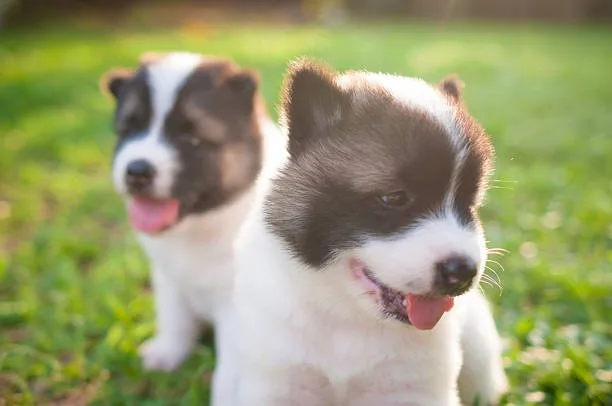
The Importance of Pre-Breeding Health Checks
Before breeding your Husky, it’s crucial to prioritize their health and well-being. Pre-breeding health checks play a pivotal role in ensuring the overall fitness of the mother and the potential litter.
How many puppies do huskies usually have? Conducting comprehensive health checks before breeding can help identify any underlying health issues that could impact the pregnancy or the puppies’ well-being. These checks encompass a range of assessments, including genetic screening, physical examinations, and testing for any infectious diseases.
By proactively addressing any health concerns, you can promote a healthier and safer breeding experience for your Husky and their future puppies.
How many puppies do huskies usually have
Regular veterinary health checks are imperative to assess the reproductive readiness and overall health of the Husky. These checks are aimed at identifying any potential risks or complications that could affect the Husky’s ability to carry and deliver healthy puppies.
Ensuring your breeding pets are in peak health is only the beginning; proper nutrition is equally crucial for their well-being and that of the upcoming litter. Discover the benefits and guidelines of a raw meat diet for huskies by exploring our detailed guide on optimal canine nutrition, "The Raw Truth: Feeding Your Husky a Natural Diet".
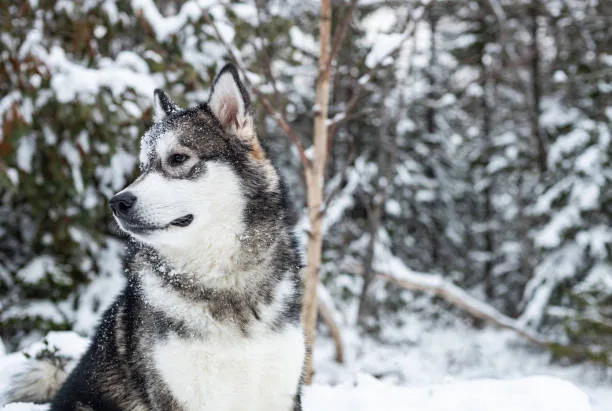
Caring for a Pregnant Husky
During the pregnancy, it is essential to pay close attention to the specific needs of a pregnant Husky. Proper nutrition is vital for the health of the mother and the development of the puppies.
A diet rich in essential nutrients, such as high-quality protein and essential fatty acids, supports the growth of the puppies and ensures the mother’s well-being. Additionally, regular, gentle exercise tailored to the pregnant dog’s needs can help maintain her physical condition and overall health.
It’s crucial to consult a veterinarian to establish a suitable exercise routine and to monitor the mother’s health throughout the pregnancy. Veterinary care is crucial for the overall well-being of the pregnant Husky.
Regular check-ups and monitoring can help ensure the health of the mother and the developing puppies.
It’s important to keep the pregnant Husky in a stress-free environment, providing her with a comfortable and secure space where she can rest and prepare for the arrival of the puppies.
Monitoring her closely for any signs of distress or discomfort is also vital. How many puppies do huskies usually have during pregnancy is essential to be prepared for the upcoming litter and to provide appropriate care for the mother as she nears the birthing process.
Enhancing your pregnant Husky's living space is just as essential. Discover the ideal crate that ensures safety and comfort for your Siberian Husky by visiting "Best Crate for Optimal Siberian Husky Comfort".
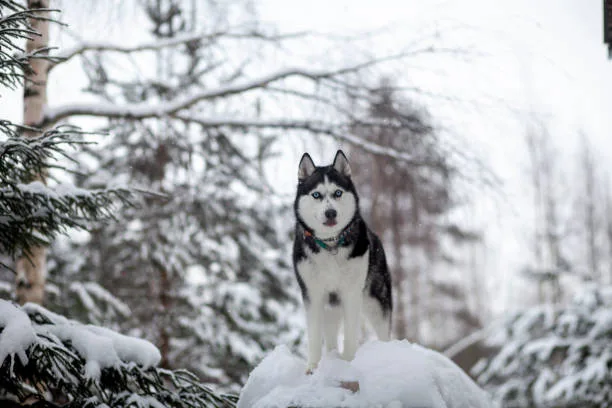
Preparing for the Arrival of Puppies
Preparing for the arrival of Husky puppies involves creating a comfortable and safe space for the mother to give birth and care for her litter. It is essential to set up a whelping box in a quiet and secluded area of your home to provide the mother with privacy and security.
The box should be large enough for the mother to move around comfortably, with low sides to allow her easy access in and out. Additionally, you should ensure that the area is warm and draft-free, as newborn puppies are particularly sensitive to temperature fluctuations.
To further prepare for the arrival of the puppies, gather essential supplies such as clean towels for drying and cleaning the puppies, an appropriately sized scale for monitoring their weight, and a heating pad or heat lamp to maintain a consistent warmth in the whelping area.
It’s also wise to have the contact information of a veterinarian readily available in case of any emergency during the birthing process.
Ensuring your home is ready for the arrival of new Husky puppies is essential, but understanding your dog's communication cues is just as important. Discover the fascinating world of Husky vocalizations and develop a deeper bond with your pet by reading our article, Unlocking the Secrets to Husky Communication.
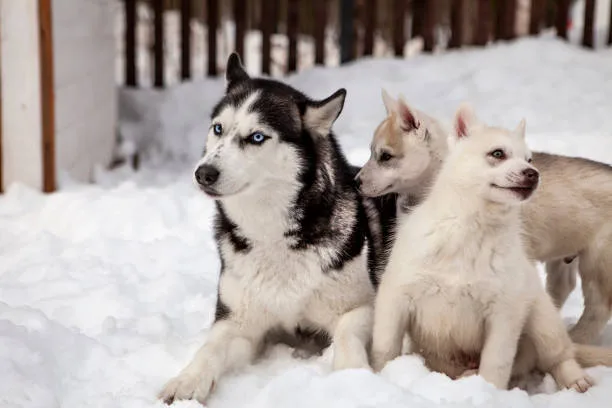
The Birthing Process and Potential Complications
Huskies generally have a gestation period of around 63 days, and the signs of labor typically become evident between day 58 and day 67. It’s crucial for Husky owners to be aware of the signs that indicate the impending birth, such as restlessness, nesting behavior, decreased appetite, and a drop in body temperature.
Once labor begins, the birthing process usually lasts between 6 to 18 hours, with each puppy being born roughly 30 to 60 minutes apart. However, it’s essential to stay vigilant as complications can arise, potentially requiring veterinary attention.
These complications may include prolonged labor, where the mother is unable to birth a puppy within two hours of active contractions, or the presence of a green discharge, which could indicate a problem with the placenta. If any signs of distress or abnormalities are observed during the birthing process, it is crucial to seek immediate veterinary assistance to ensure the safety of the mother and her puppies.
For a comprehensive overview of the birthing process and potential complications, it’s important to understand the signs of labor in Huskies and the duration of the birthing process.
Additionally, being aware of potential complications and the need for prompt veterinary attention is crucial for ensuring the well-being of the mother and her puppies.
With your newfound understanding of husky labor and birth, maintaining a clean and hygienic environment for both the mother and her pups is crucial. Explore our article on choosing the best vacuum for dealing with husky hair to ensure your home remains comfortable and spotless.
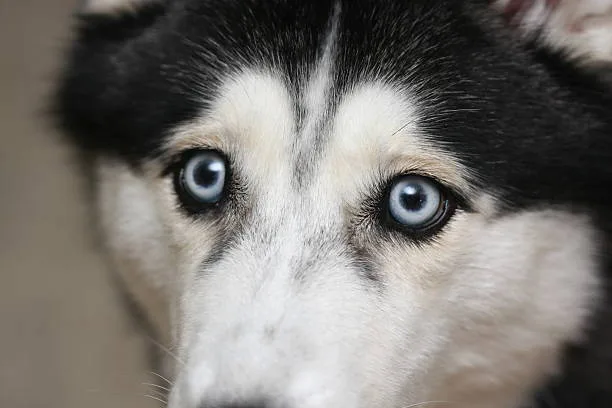
Caring for Newborn Husky Puppies
Caring for newborn Husky puppies is a critical phase that requires careful attention and nurturing to ensure their healthy development. Feeding plays a vital role in their growth, with mother’s milk being the ideal source of nutrition during the first few weeks of life.
It contains essential antibodies that bolster their immune system. If for any reason the mother is unable to nurse, a high-quality puppy milk replacer can be used as a substitute to meet their nutritional needs.
The warmth of the environment is also paramount as young puppies are unable to regulate their body temperature effectively. Providing a cozy and draft-free area, along with a heat source such as a heating pad or heat lamp, can help maintain their body warmth.
Monitoring their development is crucial as well, keeping a close eye on their weight gain, overall health, and milestone achievements. Regular veterinary check-ups are essential to ensure they are progressing as expected and to address any potential health concerns promptly.
Reddit How many puppies do huskies usually have
The care of newborn Husky puppies is of utmost importance as it sets the foundation for their healthy development.
Proper feeding, warmth, and vigilant monitoring are key aspects of ensuring their well-being as they transition into the world.
For comprehensive insights on nurturing your canine companions from infancy, delve into our detailed guidelines. Explore the capacities of these loyal companions as they grow by reading about the impressive strength of adult Siberian Huskies in our article, The Pulling Power of Siberian Huskies.

Vaccinations and Health Checks for Husky Puppies
Ensuring the health and well-being of Husky puppies involves following a comprehensive vaccination schedule and conducting regular health checks. How many puppies do huskies usually have? To protect them from common diseases, it is crucial to adhere to a vaccination schedule recommended by a veterinarian.
Vaccinations typically start at around 6-8 weeks of age and continue at specific intervals to build immunity against diseases such as parvovirus, distemper, and rabies.
Additionally, health checks are vital in monitoring the overall well-being of the puppies. Regular veterinary visits help in assessing their growth, detecting any potential health issues early on, and ensuring they are developing as expected.
During these health check-ups, the veterinarian can also provide guidance on parasite control, nutrition, and any other specific care needs based on the individual puppy’s health.
American Kennel Club: How many puppies do huskies usually have
By prioritizing vaccinations and health checks, Husky puppies can be safeguarded against common diseases and receive timely medical attention, setting the foundation for a healthy and active life.
Ensuring your Husky puppy is vaccinated and healthy paves the way for their overall wellbeing, which includes proper nutrition. Discover the dietary needs and feeding guidelines for these energetic canines by exploring our comprehensive guide, Feeding Your Husky Puppy: A Nutritional Journey.
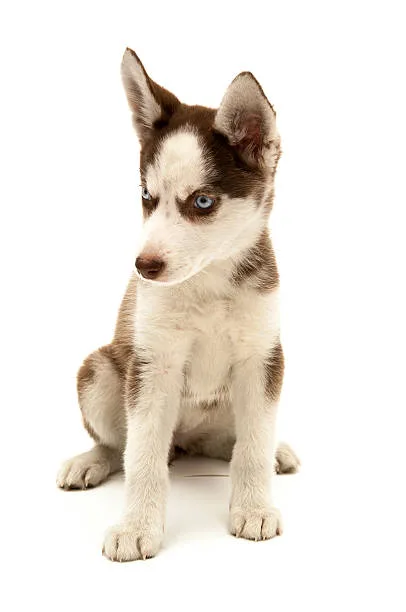
Socialization and Training for Husky Puppies
Huskies are known for their strong-willed and independent nature, making early socialization and training crucial for their development. Proper socialization exposes Husky puppies to various people, animals, and environments, helping them to become well-adjusted and confident adults.
Introducing puppies to different stimuli in a positive and controlled manner from an early age is essential in preventing behavioral issues commonly associated with the breed. This process also teaches them how to interact appropriately with other dogs and humans, reducing the likelihood of aggression or anxiety in adulthood.
Training is equally important and should focus on establishing basic obedience, impulse control, and good manners. Consistent and positive reinforcement methods work best, as Huskies respond well to rewards and praise.
This approach sets the foundation for a strong bond between the owner and the Husky, ultimately leading to a well-behaved and happy companion. Proper socialization and training go a long way in ensuring that Husky puppies mature into well-adjusted and well-behaved adults.
On Quora about: How many puppies do huskies usually have
It is essential to introduce Husky puppies to various stimuli in a positive and controlled manner from an early age to prevent behavioral issues.
- Socialization helps in reducing the likelihood of aggression or anxiety in adulthood.
- Training should focus on establishing basic obedience, impulse control, and good manners using consistent and positive reinforcement methods.
.
To explore the joys of bonding with a unique breed that benefits from the same principles of socialization and training, consider the charming corgi husky mix. Discover how to welcome a furry companion into your life with the potential to become a well-rounded family member by visiting Planet Husky for your ideal corgi husky mix.
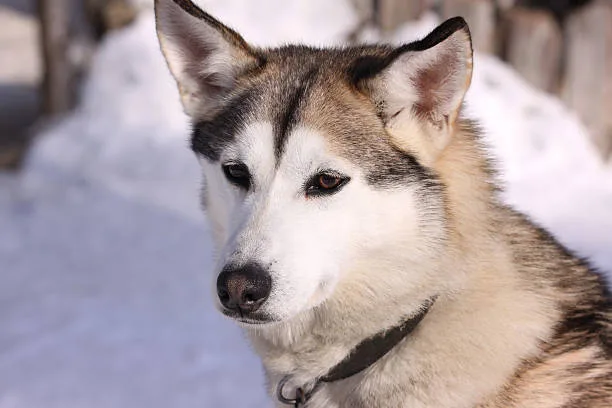
When to Find Homes for Husky Puppies
Deciding when to find homes for Husky puppies is a crucial consideration for their well-being and future development. It’s important to prioritize the developmental needs of the puppies when determining the ideal time for them to transition to their new homes.
A responsible approach involves ensuring that the puppies have received sufficient time for socialization with their littermates and mother, which typically occurs between 7 to 8 weeks of age. This stage is critical as it allows them to learn important social skills and behavior from their mother and siblings.
This period also enables the puppies to develop confidence and independence, setting a solid foundation for their future interactions and relationships. Additionally, it’s essential to find suitable homes that align with the specific needs of Huskies, considering their energetic nature and exercise requirements.
Therefore, focusing on responsible placement that considers both the individual needs of the puppies and the capabilities of potential adopters is vital for their long-term well-being. Making sure the puppies are placed in caring and nurturing environments that can accommodate their unique traits and provide the necessary attention and care is fundamental to their future happiness and development..
To ensure you are fully prepared for every aspect of puppy care, it is essential to understand the potential size of the litter you will be managing. Dive deeper into the breeding intricacies of a popular breed with our in-depth article on Husky litter sizes.
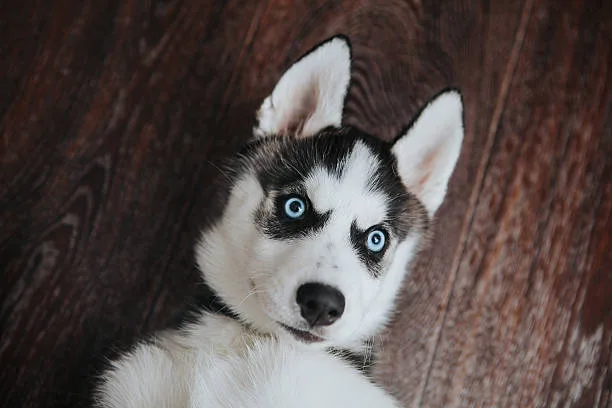
Best Practices in Responsible Husky Breeding
When it comes to responsible Husky breeding, it’s crucial to prioritize the health and well-being of the breed. This involves conducting thorough health screenings for potential parent Huskies to identify and address any genetic or health-related concerns that may impact the litter.
Additionally, selecting the optimal breeding age is essential for ensuring the mother’s and puppies’ health. Early or late breeding can pose risks, affecting the litter size and the mother’s ability to care for the puppies effectively.
Another vital aspect is the practice of spaying and neutering Huskies to prevent overpopulation.
This not only helps in controlling the Husky population but also has health benefits for the animals themselves. It can reduce the risk of certain cancers and behavioral issues, contributing to the overall well-being of the breed.
By following these best practices, responsible Husky breeding can help maintain the health, temperament, and population of this beloved breed.
To explore further nuances in canine breeding practices and preferences, consider the intriguing contrasts between popular Lab variants. Gain insights on the characteristics and considerations between Charcoal and Silver Labs by visiting Discover Your Perfect Pet: The Charcoal Lab vs Silver Lab Debate.
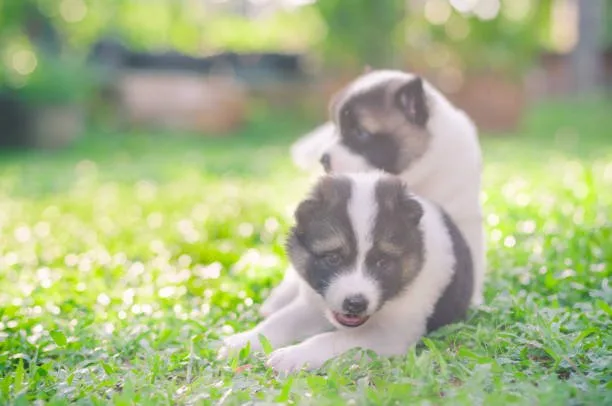
Optimizing Pup Health: Nutrition, Vaccination, and Exercise for Huskies
Huskies require special attention to their nutrition, vaccination, and exercise to ensure their overall health and well-being. A balanced diet is crucial for Husky puppies, providing them with the essential nutrients for growth and development.
A regular vaccination schedule is also important to protect them from common diseases and ensure their long-term health. In addition, appropriate exercise routines are vital for Husky puppies to maintain their physical fitness, mental stimulation, and overall well-being.
It’s essential to create a healthy and active lifestyle for Husky puppies from the early stages to support their optimal development and ensure they become healthy and happy adult dogs.
Remember, a balanced diet, regular vaccinations, and appropriate exercise are the cornerstones of Husky puppy health and well-being.
For further insights on nurturing your Husky puppy, delve into our comprehensive article, where expert guidance awaits. Discover the full spectrum of canine care, from nutrition to wellness routines, by visiting Dogs on Youtube.
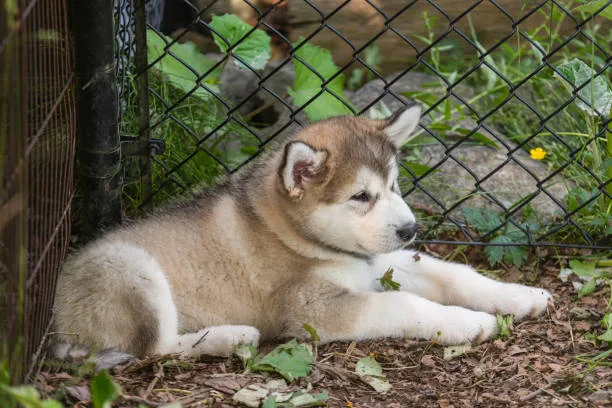
Developmental Milestones and Weaning of Husky Puppies
Huskies go through several crucial developmental milestones as they grow, and weaning is a significant phase in their early lives. This process typically begins at around 3 to 4 weeks of age, as the puppies start to show interest in solid food.
It’s essential to introduce them to a high-quality puppy food that is specially formulated to meet their nutritional needs. This gradual transition from mother’s milk to solid food should be closely monitored to ensure the puppies are adapting well and receiving the necessary nutrients for their growth.
During this time, it’s important to provide a mix of puppy food and water in shallow dishes to encourage the puppies to lap and nibble.
The mother may still nurse the puppies during this period, but her role in their nutrition gradually diminishes as they become more reliant on solid food. Weaning should be a gentle and gradual process, taking into account the individual needs and development of each puppy.
- Close observation of the puppies’ weight and appetite is crucial during the weaning process.
Any signs of reluctance to eat or weight loss should be promptly addressed, and a veterinarian’s guidance may be necessary.
- Proper hygiene and cleanliness of the weaning area and feeding dishes are vital to prevent potential health issues as the puppies adjust to solid food.
- As the weaning stage progresses, the puppies will become more independent in their feeding habits, and their engagement in play and exploration will also increase, marking an essential step in their overall development.
The weaning phase sets the foundation for the puppies’ nutritional needs and independence in feeding, paving the way for their growth and well-being as they transition into adulthood. Understanding and supporting this process is crucial for the healthy development of Husky puppies..
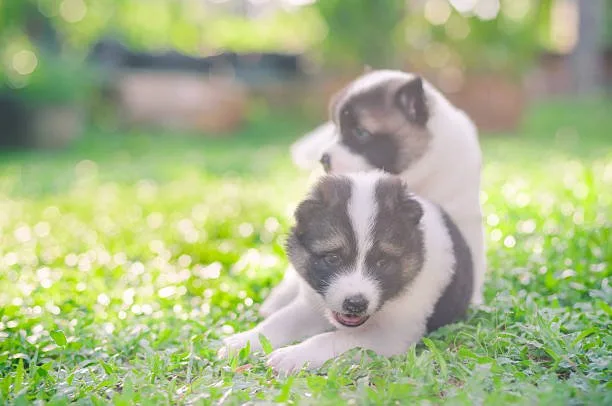
Socialization and Training Fundamentals for Husky Puppies
Socializing and training are crucial aspects of raising a well-adjusted Husky puppy. Proper socialization helps puppies grow into confident and well-behaved adults.
Exposing them to various environments, people, and other animals from a young age is essential for their development. Additionally, early-stage training sets the foundation for obedience and good behavior.
Consistent, positive reinforcement methods, such as rewards and praise, are effective in teaching basic commands and establishing a strong bond between the puppy and its owner. It is important to start training early to address any behavioral issues and ensure a harmonious integration of the Husky puppy into its human environment.
When introducing a Husky puppy to new experiences and social interactions, it’s important to do so gradually and in a positive manner.
Exposing them to different sounds, surfaces, and experiences in a controlled and reassuring way helps them build confidence and adaptability. This can prevent fear-based behaviors and anxiety in the future.
- Regular, positive exposure to new people, animals, and environments
- Consistent use of positive reinforcement for early training
- Starting training early to address behavioral issues and establish obedience
.

Post-Birth Care: Managing the Husky Whelping Process and Ensuring Pup Welfare
After the successful whelping process, it is crucial to monitor the mother and puppies closely to ensure their well-being. The mother should be given a comfortable and quiet space to rest and bond with her puppies.
How many puppies do huskies usually have in a litter can significantly affect the mother’s postnatal care needs, so it’s essential to tailor the care to the litter size. Regular veterinary check-ups for the mother and the puppies are essential to ensure they are healthy and thriving.
Additionally, providing a warm and clean environment for the mother and her litter is vital for their overall health. It is important to observe the puppies for healthy feeding and growth and address any concerns promptly.
Moreover, supporting the mother with a nutritious diet and adequate hydration is crucial during this post-birth phase. Emphasizing the significance of postnatal care for both the mother and the puppies is essential for their optimal growth and well-being.
It’s important to keep a close eye on both the mother and the puppies during this critical post-birth period.
Overall, managing the Husky whelping process and ensuring pup welfare involves closely monitoring the mother and the puppies, providing a comfortable environment, ensuring regular veterinary check-ups, and addressing any concerns promptly for their optimal care and well-being.
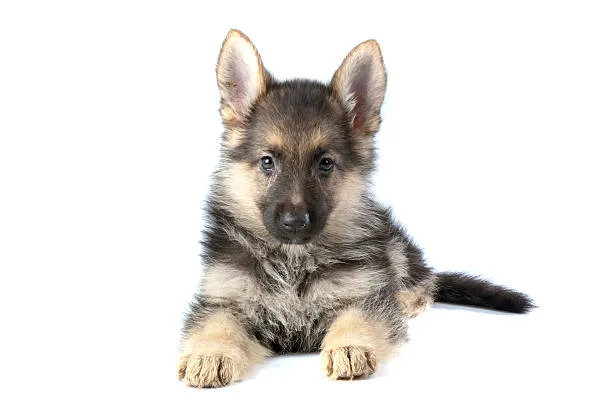
Summary and Conclusion
How many puppies do huskies usually have? Huskies usually have an average litter size of 4 to 6 puppies. This number can be influenced by factors such as genetics, health, and age.
It’s important to ensure the mother husky receives proper pre-breeding health checks to guarantee a healthy litter of puppies. During the pregnancy, it’s crucial to provide the mother with specific care, including a balanced diet, regular exercise, and veterinary check-ups.
Additionally, preparations should be made for the arrival of the puppies, understanding the birthing process and being aware of potential complications that may arise. Once the puppies are born, it’s essential to provide them with proper care, including feeding, warmth, and monitoring their development.
Vaccinations and health checks are crucial to safeguard the puppies from common diseases. Furthermore, the significance of socialization and training for the puppies to ensure they grow up well-adjusted and well-behaved cannot be overstated.
Responsible placement of the puppies in new homes should also be considered, taking into account their developmental needs. Ultimately, the well-being of both the mother husky and her puppies is of utmost importance, and proper care and attention are crucial for their health and happiness..

Leave a Reply